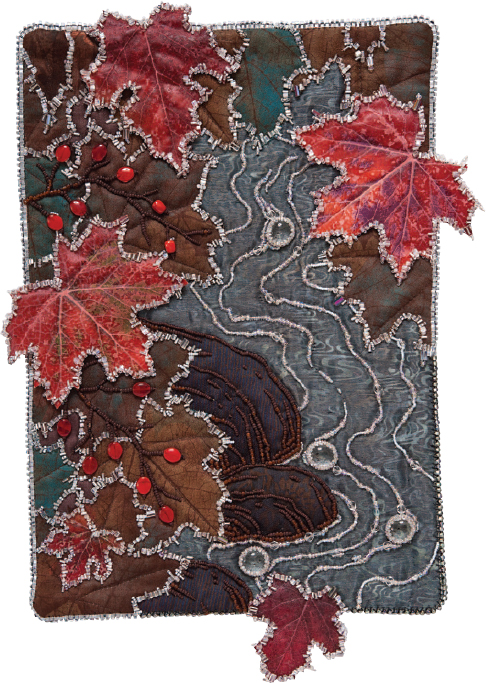
1
Why Use Beads on Your Quilts?
Why use beads on a quilt? I would as well ask you, why sing, why dance, why write poetry or paint paintings? I’ve been fascinated with beads ever since the early ’70s when I managed a craft gallery and was gifted with some lovely African trade beads. I didn’t know they were valuable then, only that they were beautiful. I took apart strands and made jewelry for myself and others. Later, I drilled holes in some shells I had gathered on Ocracoke Island, North Carolina, thereby making them into beads in the time-honored tradition. I still have a necklace from those shells, although I never wear it. But I digress. Beads do that to me.
Why quilt? Why sew together pieces of fabric to make a larger piece of fabric? Whatever your reason, the point is that the love of making quilts is rooted in fabric and thread and creating a whole out of pieces.
When you start, what do you start with? Is it the fabric color? The print? Is it a block pattern, or what you want to do with the block now that you know how to put it together? What is it that drives you to finish, at least the top of a quilt? The answers are as numerous as the number of people making quilts, and that, as we know, is a whole bunch.
And what about art quilts—not so much why make art quilts, but what drives such quilts? “Why do I want to make this particular quilt?” precedes “How do I construct it?” Again, the answers are as numerous as the people making art quilts; it might be a technique, the fabric, an idea, a picture, a love of cows or watermelons, or any combination thereof.
Then, when the quilt top is sewn together, the question becomes, what now? How shall I quilt it? How shall I bind it? What kind of batting shall I use? What fabric shall I use for a backing? And then there is the question that often governs the answers to the others: What is it going to be used for?
This is where I get back to beads. Remember beads? I usually start from the bead end and not the quilt aspect when designing quilts. I enjoy sewing them onto fabric, as in bead embroidery. The New Century Dictionary defines the word embroider as “to decorate with needle work, to adorn or embellish.” The problem was that the style of bead embroidery I had first learned called for the whole design to be carried by the beads, and I would wind up covering most or all of the fabric with beads. It was not mere embellishment. And it was time consuming in the extreme. Sewing beads on quilts gave me more texture than regular flat bead embroidery and allowed me to leave areas of fabric exposed. When I looked at quilts that had beads sewn onto them, I saw little dabs of beads here and there. One had to get up very close to even see the beads. My quest became to find the balance between the fabric and the beads and to give both a voice in the design, rather than to use beads to embellish the design. Why? Because I liked beads, and I wanted a larger canvas to use them on. Having painted with watercolors and inks, with oils, and with acrylics, painting with beads was a logical step in making pictures, with fabric as the canvas.
Going back to choices for a moment, showcasing beads became my main reason for making small art quilts. Needle and thread, fabric and beads, handwork—all working together to make something that didn’t exist before. You might want your piece to say something as simple as “I’m pretty,” or something very important to you. In the beginning, most of my pieces were driven by what was printed on the fabric. Now, I might augment the printed design with Sharpie waterproof pens, dyes, or paint first, but mostly I use beads to draw lines, create texture, and add sparkle.
Back to the original question: “Why use beads?” My answer is “I love them! I love their infinite variety, size, shape, color, and finish, and what they can add to a surface.” Why use plain stitching when you can use a bead with a color or finish that will add to the surface? Should you become a “beadaholic” like me, you may find yourself using beads for everything, when a piece of couched yarn or some machine top stitching would suffice. While we’re asking questions, why not ask, “When do you stop?” Answer: “When you’re done!” or, more precisely, “When you’ve reached the proper density of beads for that piece and have a balance between the beads and the fabric.” Of course, there are other factors to be considered, such as when you’ve run out of time or patience … or you’ve run out of beads.

Early Frost, 2007, 9″ × 13″
Because They’re There
Why incorporate beads into the designing of your quilt? Because beads are beautiful in and of themselves, and they do things that can’t be done easily any other way. Sprinkle a few teardrops of clear glass with an AB (Aurora Borealis) finish over the surface of a leaf and you have raindrops. Run clear hex beads around a leaf and you have frost, or use lines of various sizes of clear Iris seed beads to create bubbles in a stream of water. Sometimes pieces, such as Early Frost, are designed around the beading because you want to work with an effect. At other times, a piece needs beads and you have to figure out what will work with that piece. There are times when I put beads on a quilt just because that’s what I do. When the quilt top is finished, I go through my bead stash and see what will work and then go shopping for what I don’t have but want to see on that quilt. The following section contains suggestions as to how you might start thinking in terms of where you could use beads to create a specific visual effect.
Designing Pieces around Wonderful Beads
Sometimes you have, are given, or buy beads that you just love but don’t know what to do with. The green Chinese turquoise beads that form the snake in Tenuous Membrane are just such an example. I bought two strands of large, flat, irregularly shaped Chinese turquoise beads at a gem show because I liked them. They sat around for a couple of months, and I finally decided I had to use them in something. I got out fabric that the turquoise would complement and dove in. The result was Tenuous Membrane.

Tenuous Membrane, 2010, 29″ × 44″
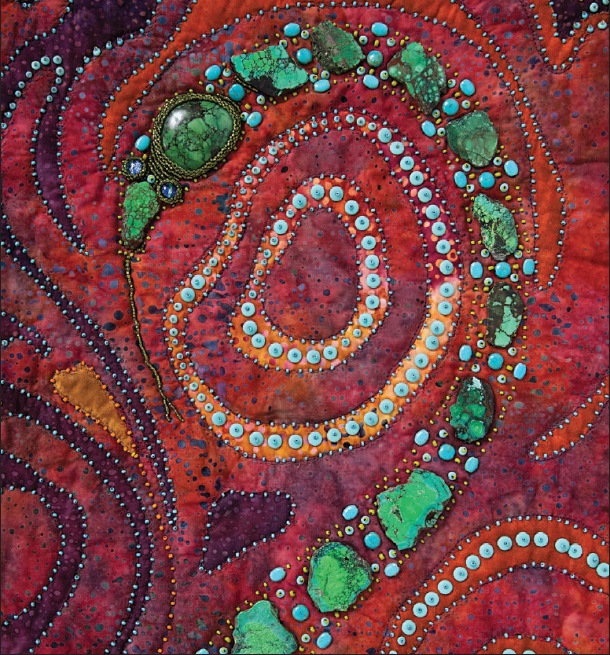
Chinese turquoise beads in Tenuous Membrane (page 11)
The quilt that emerged was designed around two things: merging the narrow strip of Kaffe Fassett fabric (all I had) on the left with the batik on the right, and creating a home for the large green turquoise beads. I used reverse appliqué to integrate the two fabrics, adding more color as needed to heighten the illusion of leakage back and forth across the line. The head of the snake is a cabochon (a gemstone which has been rounded and polished as opposed to faceted) of Chinese turquoise held to the fabric with a bezel of beads (page 74). The rest of the large green pieces are actually beads with holes through them, so they could be sewn on one at a time. I was careful to secure them all the way through to the back of the quilt and to go through each bead several times.

Examples of stone slabs with holes drilled through
NOTE
Most stone beads are drilled with a sharp-pointed drill entering the bead at each end and meeting in the middle. When the holes do not exactly meet, there is a tiny sharp point in the hole that can cut any kind of thread. When using stone beads on fabric, be sure they lie flat and cannot move around, thereby causing friction and cutting the threads used to secure the beads. It would be wise to go through the hole as many times as the diameter allows.
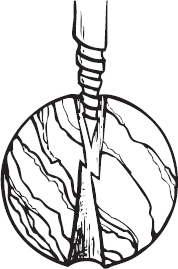
Hole drilled in stone bead
Stone and shell discs with large holes can be sewn on with the same or a different color of thread, which can become a design element in itself.
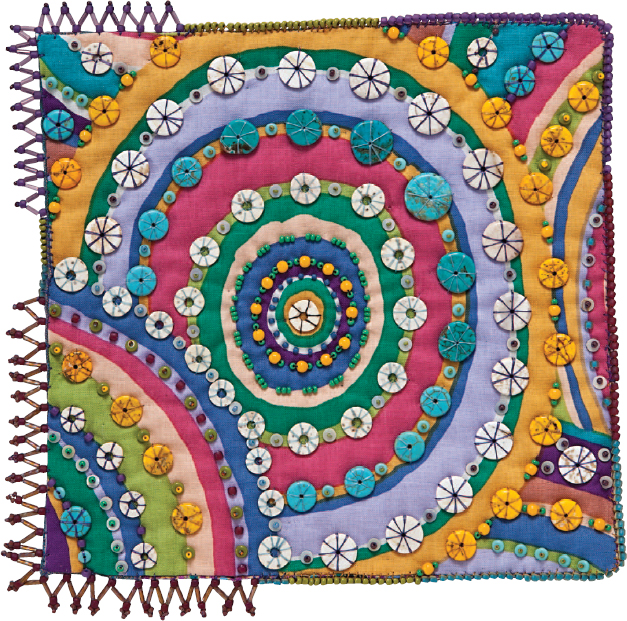
Blue and white magnetite and various shell discs
Another example of a quilt designed around beads is Partial Eclipse. I wanted to work in BRIGHT colors! I got out some vintage bugle beads in a strange tomato color, some large vintage nailhead beads in a bright red-orange, some dyed turquoise discs of magnetite that I wanted to feature, and some pointy little oval nailheads in a yellow-orange. Then, getting out fabric in colors that sang to me, I pieced and reverse appliquéd a quilt top to put all those beautiful beads on. The piece was designed for the blue turquoise discs and the nailhead beads and as a venue for lots of bugle beads. Note also the purple and green background with dots; some are fabric, and some are beads. Halfway through beading the piece, I was reminded that availability is a design element. I discovered that I was about to run out of the bugle beads and pointy oval nailheads, so I faced the question of whether this design element would be sparse or lavish. I contacted the merchant I bought them from, and fortunately, more of both were available, so I could be lavish.

Nailhead beads have two sets of holes and are usually concave.
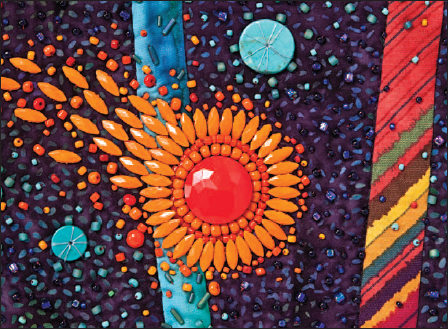
Round, orange, and pointy oval nailhead beads in Partial Eclipse (page 106 )
Partial Eclipse is also an example of creating texture with beads. Note the very different textures created with bugle beads. On the “sun” I used bugles in a random pattern, especially around the edges, to denote movement and instability. On the “moon” the bugles become part of the design of the pattern, running parallel to the lines in the fabric and also around the outside edges to give a soft-edge look and extend the color beyond the actual edge.
In the “land” at the bottom, I used the large vintage bugles with seed beads on top to suggest grass or at least something growing. By placing clumps of beads with the bottoms of the stalks closer than the tops, I was able to texture and quilt the area.
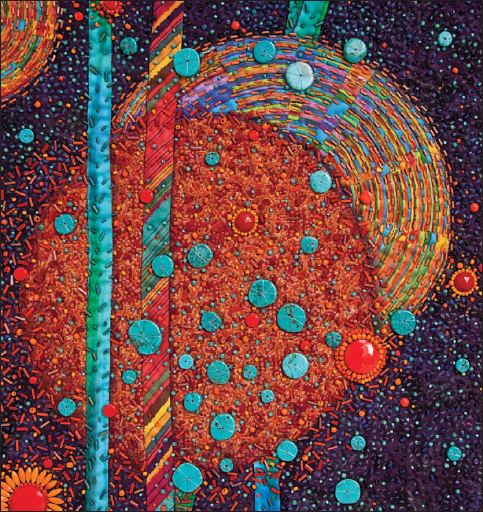
Sun and moon in Partial Eclipse

Grass in Partial Eclipse (page 106)
In My Father’s Shadow, I did the same thing only more so. All the lines of bugles and seed beads extend upward and outward from a central area to suggest clumps of grasses. Note how perspective is achieved by creating shorter, smaller clumps as the grass recedes up the hill. I went from using two or three beads per grass blade to one bead, and then I finally had to resort to breaking the beads in half and sanding the sharp edges to do the final clumps.
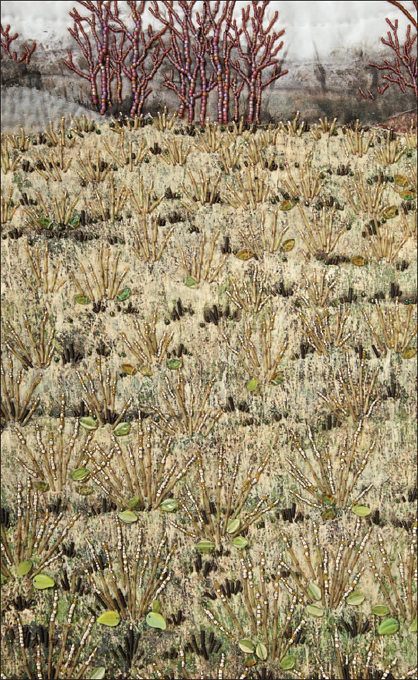
Grass in My Father’s Shadow (page 99)
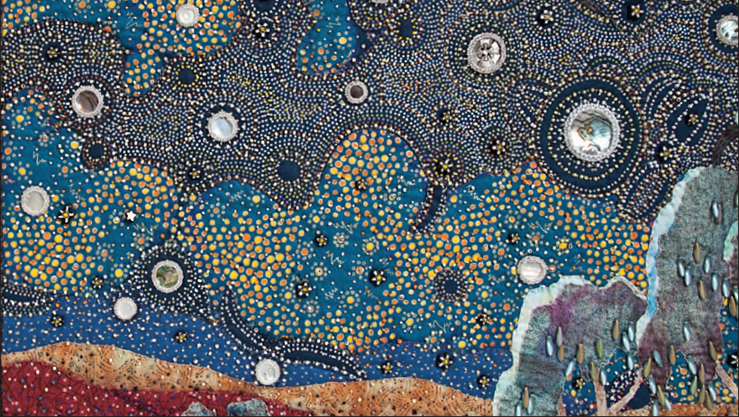
Sky in Australian Dreamscape (page 104)
Single seed beads (page 51) and stacks (page 55) can also be used to add color or punch up color in an area. In the sky of Australian Dreamscape, I used beads and colored Sharpie pens to merge the three fabrics into one whole. All three fabrics have dots on them, and I recolored some of those dots with pens. Then, I filled some of the dots with seed beads, quilting the surface and suggesting that there are many more beads than there actually are. Notice the abalone button blanks with beaded bezels (page 74).
The sky of Partial Eclipse was created in a similar fashion. It is a dotted batik fabric, and I used #8 color-lined blue seed beads to deepen the color of the sky. Then, quilting through all the layers of fabric and batting, I added #11 turquoise, red, and orange beads to extend to the sky and carry color further from the larger beads. The blue, turquoise, and orange beads were all sewn on at the same time, as I was working area by area rather than color by color. Notice that the red and orange beads get smaller the farther they are from their “planets.”
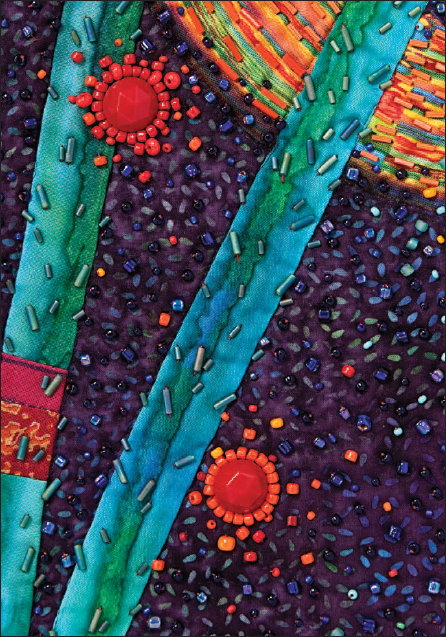
Sky in Partial Eclipse (page 106)
In At Risk, I wanted to incorporate lots of insects. My parents were both entomologists, and they enjoyed gardening. I wanted to create something that included both elements as a memorial to them and the garden that they had lavished some twenty-odd years of love and hard work on. I was working in the kaleidoscope venue (thank you, Paula Nadelstern) and decided I needed a spiderweb to catch some of the moths and butterflies I had gathered for the piece. Thinking of how stunning spiderwebs look all spangled with dew, I put the web in, line by line, with clear glass beads. The main support lines were plotted out first and drawn in with chalk. Then, the short lines went in, spiraling out from the center. Because the web had been built into the framework of the piece, it looked like it belonged there. The web had to have a spider, so I commissioned a friend to do a lampwork bead for the body. I gave him an enlarged photo of a yellow garden spider, and he gave me back the beautiful bead you see in the photos. I added long, shiny black bugle beads for legs, and the result was something only beads could have done.
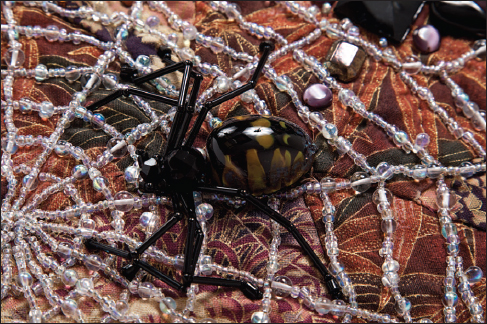

Web and spider in At Risk (page 100)
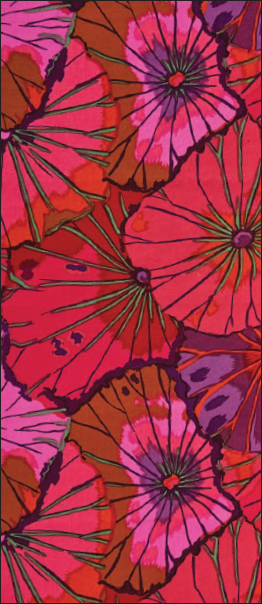
Kaffe Fassett fabric without beads
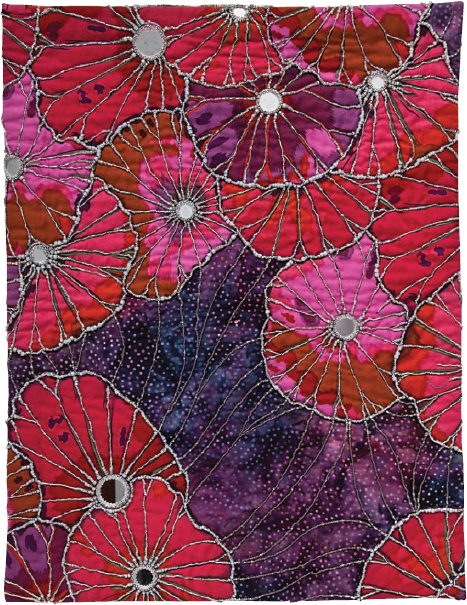
Connections, 2010, 15½″ × 20″
Connections was a quilt I designed for a demonstration of mirror bezels. Using some of my favorite Kaffe Fassett fabric, I appliquéd the flowers and then machine stitched the lines around the petals and between the flowers. Next, I placed mirrors in the centers of the flowers, using beaded bezels (page 74). Then, I beaded over the stitched lines of the flowers and around each petal, carrying the silver of the mirrors and the beads around the mirrors into the flowers. I beaded the lines connecting the flowers with pale lavender #15 silver-lined beads, so they would be “almost there”; they connected the flowers more than the stitching did, but not as noticeably as if I had used the same beads as around the petals. This is an example of working with the lines in the fabric, as well as creating lines over the fabric.
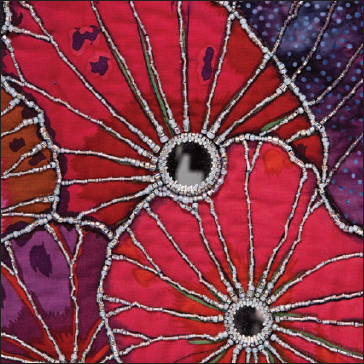
Flowers in Connections
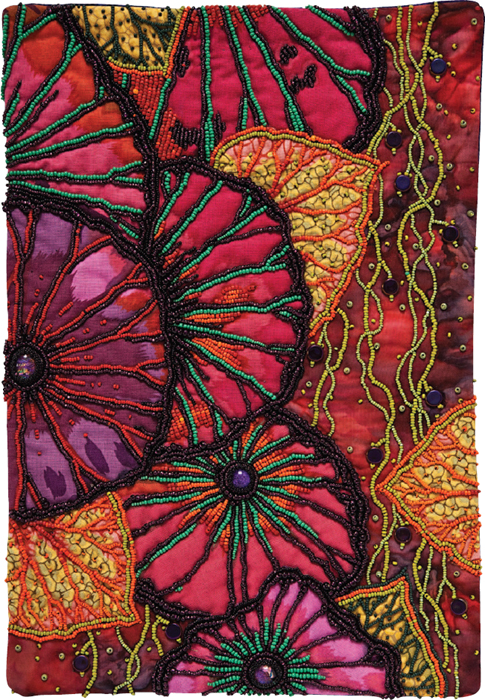
August—thank you, Kaffe Fassett—is another example of beads as lines, using the same fabric but different beads. Note the change of color values in the piece as the lines in the flowers repeat existing colors in the fabric. The color of the center stones also gives depth to the piece that is quite different from the mirrors in Connections.